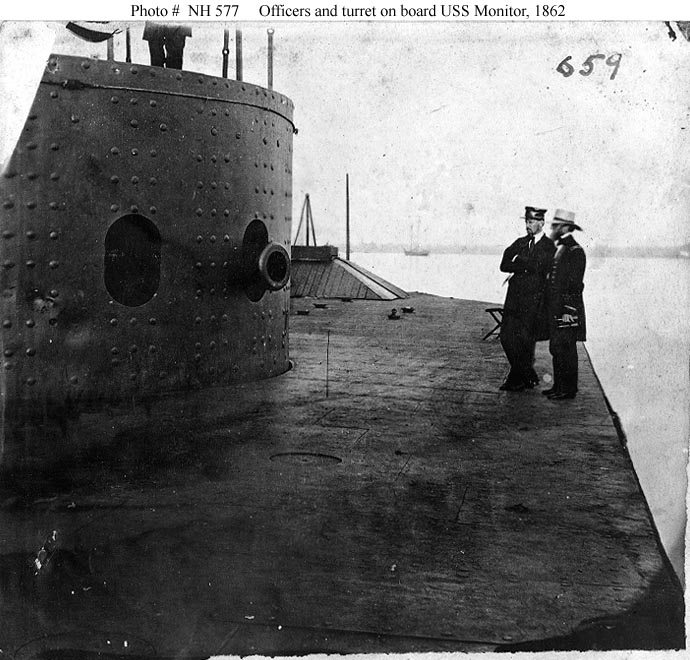
This page displays and discusses images that have something to do with the book. Some appear in the book, while others do not. In some cases the image is shown directly in this page. In other cases, a "thumbnail" image is diplayed. In other cases, there is a link to a source of images on another website.
This page was originally a planning document for the book, and remains for the time being as an interim means of displaying these pictures.
From http://showcase.netins.net/web/creative/lincoln/education/patent.htm
On May 22, 1849, Abraham Lincoln received Patent No. 6469 for a device to lift boats over shoals, an invention which was never manufactured. However, it did make him the only U.S. president to hold a patent. Shown here is his scale model at the Smithsonian Institution in Washington, D.C.
I just discovered that Google shows patents. http://www.google.com/patents?vid=USPAT6469 will show you the patent itself and the drawings for it.
Code book, "Cipher for Telegrahpic correspondence" at NSA museum
Lowe made an aerial map of defenses around Richmond for McClellan. It's big and rarely seen. In special manuscript division of the Library of Congress: terrific map that Lowe produced during the Peninsula campaign. Info on same:
Lowe made frequent flights to obtain tactical intelligence. On June 14, 1862, for instance, he went aloft near Richmond carrying a map on which he noted, in red, "some of the most important earth works seen this morning." The map had been prepared by John C. Babcock and "E. J. Allen S.S.U.S."-the cover name of Allan Pinkerton. The initials stand for " Secret Service, United States," Pinkerton's name for the organization he formed while working for McClellan.
this map is in the Rare Manuscripts (or Rare Documents) room of the Library of Congress. It's big but could probably be excerpted to show the fortifications in red. Alternately, achat levitra pas cher, could be poster.
Note: for photos of Monitor showing dents in turret caused by Viriginia see the following:
http://www.history.navy.mil/photos/sh-usn/usnsh-m/monitr-o.htm and many other images. Link to dented turret http://www.history.navy.mil/photos/images/h00001/h00577.jpg.
It depends on the reproductions probably, but I think this image: http://www.history.navy.mil/photos/images/h61000/h61923.jpg shows the dents better.
No overall photo of the Monitor is known to exist.

Click on the above thumbnail for a large view of this cartoon of McClellan directing his Peninsular Campaign from a gunboat.
On Burton, inventor of the version of the "minie ball" used in Civil War. Sketches of the bullet design, etc. http://www.nps.gov/hafe/photosmultimedia/index%2Ehtm?eid=103762&root_aId=69#e_103762
http://www.nps.gov/hafe/historyculture/james-h-burton.htm
Lincoln Target Board -- the piece of wood lincoln shot into -- is at this museum:
http://www.il.ngb.army.mil/Museum/Current/CurrentExibitFlash.htm
It's a little tricky to navigate to the page with the pertinent info, so I did a screen grab of it and enlarged it a bit. At least one account has Lincoln shooting into a fairly deep piece of wood, with the short-into end being sawed off later as a souvenir, so the painting of Lincoln plugging away at a thin board might not be accurate. Below the photo of the painting for more links.
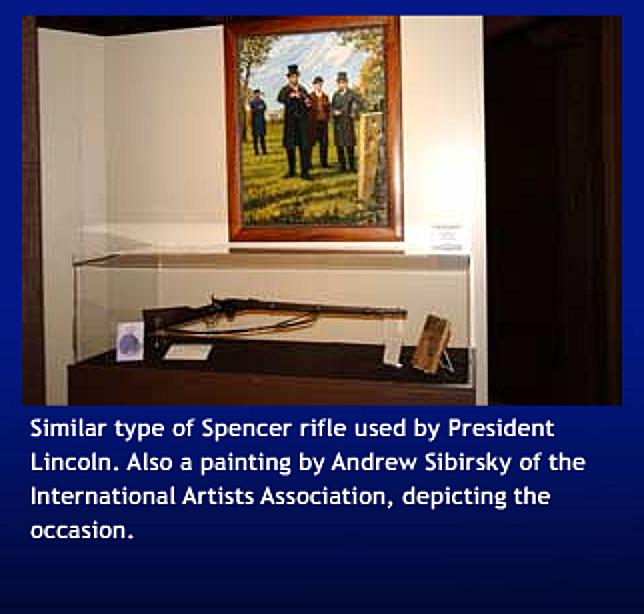
See page 12 of the CACNews (News of the California Associations of Criminalists), 3rd quarter 2006 edition, PDF available at http://www.cacnews.org/pdfs/3rdq06.pdf for photo of the Lincoln Target Board and forensic analysis of it. See also
http://afte.org/TrainingSeminar/AFTE2006/Summaries/afte2006_thurs.htm.
Extracts from a paper on The Lincoln Target Board...
Lucien C. Haag, Independent Examiner, Carefree, AZ
Objectives:
In August of 1863 Christopher Spencer had a private meeting with President Abraham Lincoln where he presented his revolutionary 7-shot repeating rifle to the President. The next day Lincoln fired a full magazine at an improvised target fashioned from a pine board. Lincoln was so impressed with the Spencer that he personally endorsing it and set aside General James Ripley's opposition to the purchase of repeating cartridge guns for the Union Army. The Spencer rifles and carbines became the most dreaded and hated gun by the Confederates who fought the entire war with single shot muzzle-loading rifles and muskets. Spencer retained the target board for many years then sent it to the State of Illinois where it purportedly was lost in the mist of time.
The Lincoln Target Board has been found and the author was allowed to personally examine and photograph it at the Illinois State Military Museum in his home town of Springfield, Illinois. The Lincoln Target Board allows us to see what sort of marksman our 16th president was but the bullet holes in the board raise some question as to just what version of the Spencer rifle President Lincoln fired on that historic and fateful day in August 1863. The knowledge gained from the previous presentation on bullet holes in wood will be used to show what can be reasonably concluded from the dimensions of the bullet holes in this most famous of all targets.
[see Scientific American Jan 25, 1862 for Spencer Rifle illo.] Click on thumbnail below for large image.
or go to
http://cdl.library.cornell.edu/moa/ and browse to SciAm for above date.
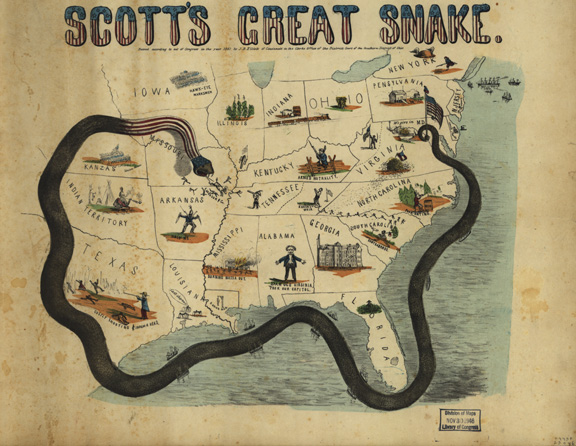
There is a version of this cartoon of the Great Snake, AKA the Anaconda Plan, available from the Library of Congress Shop
at http://www.loc.gov/shop/index.php?action=cCatalog.showItem&cid=14&scid=235&iid=3271
Click on this thumbnail for a larger view of this Harper's Weekly cartoon of the British John Bull
(with an eye for Pounds Sterling) showing just how neutral he was. This is from Harper's Weekly.
See http://www.sonofthesouth.net/leefoundation/civil-war/1862/november/john-bull.htm. See the Maryland Confed. cartoon at same page.
Here's a cartoon from the same source showing a Northern civilian who has just been "paid" by a Confederate soldier for goods the Confeds. have taken.
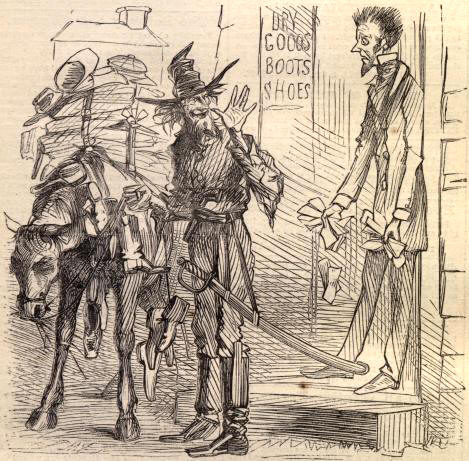
caption:
"MY MARYLAND MARYLAND!!!"
CONFEDERATE LIBERATOR. "We come to free you all, my friend, from the Iron heel of LINCOLN and his hordes! We take nothing without paying for it! Your hour of freedom has come. Be Happy! be Happy!"
DEVOTED SECESH. Yes! oh, yes! Our feelings, and all that sort of thing, are with you. But, good gracious! haven't you got a Green Back or two? How the d— —l am I going to fill up again with this trash!!!"
I lifted this cartoon of Raphael Semmes from The Civil War at Sea. Semmes was the captain of the ALABAMA. The "290" on his sword is a reference to the term "hull 290" that being what his ship was called in the shipyard while she was being built, because no one knew (nudge, nudge, wink wink) that she was going to be a Confederate Commerce raider. I don't know, but this would appear to be the web page of the people who have the print: http://www.uacc.org/dealers/jameslowe.html
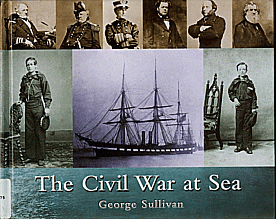
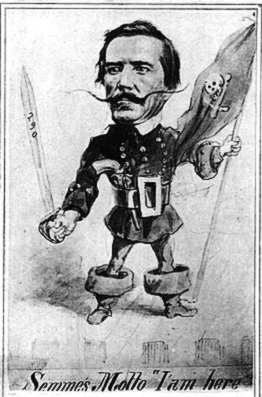
See page 12 of the CACNews (News of the California Associations of Criminalists), 3rd quarter 2006 edition, PDF available at http://www.cacnews.org/pdfs/3rdq06.pdf for photo of the Lincoln Target Board and forensic analysis of it. See also
http://afte.org/TrainingSeminar/AFTE2006/Summaries/afte2006_thurs.htm.
Extracts from a paper on The Lincoln Target Board...
Lucien C. Haag, Independent Examiner, Carefree, AZ
Objectives:
In August of 1863 Christopher Spencer had a private meeting with President Abraham Lincoln where he presented his revolutionary 7-shot repeating rifle to the President. The next day Lincoln fired a full magazine at an improvised target fashioned from a pine board. Lincoln was so impressed with the Spencer that he personally endorsing it and set aside General James Ripley's opposition to the purchase of repeating cartridge guns for the Union Army. The Spencer rifles and carbines became the most dreaded and hated gun by the Confederates who fought the entire war with single shot muzzle-loading rifles and muskets. Spencer retained the target board for many years then sent it to the State of Illinois where it purportedly was lost in the mist of time.
The Lincoln Target Board has been found and the author was allowed to personally examine and photograph it at the Illinois State Military Museum in his home town of Springfield, Illinois. The Lincoln Target Board allows us to see what sort of marksman our 16th president was but the bullet holes in the board raise some question as to just what version of the Spencer rifle President Lincoln fired on that historic and fateful day in August 1863. The knowledge gained from the previous presentation on bullet holes in wood will be used to show what can be reasonably concluded from the dimensions of the bullet holes in this most famous of all targets.
---------------
This is a linen-wrapped cartride for a Sharps rifle. Image from http://www.picketpost.com/bullets.htm (a commercial firm selling Civil War memoriabilia)
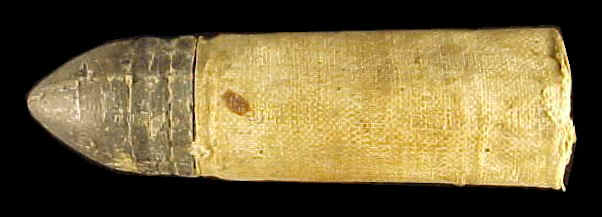
See http://www.peninsulacampaign.org/technology.shtml
for a nice profile sketch of the Monitor. It's not good enough quality for book use, but could serve as a reference, or it might be possible to backtrack to a better quality original. (Later -- I think this is based on this image: http://www.history.navy.mil/photos/images/h50000/h50954.jpg.
See http://blogs.princeton.edu/writingart6/archives/2005/01/nonmanet_nonunf.html for various views of Kearsarge v. Alabama -- including one by Manet! A History of the Confederate Navy says that Manet was present, but the above website says he wasn't actually there.
http://www.numa.net/expeditions/james_river_search.html reports this: There has been a bit of mystery about the Greyhound. Some historians have confused her with the much larger British-built Confederate blockade runner of the same name that was captured in May of 1864. They were definitely two different ships. There is a painting of her by James Bard and a photograph may be found in the Mariners Museum at Newport News. There is no further context to make it clear which ship is in the painting and photo. My guess is it's Butler's. (In later research, see below, I located an image of the photo. The photo is of Butler's Greyhound. It would be worth inquiring at the Mariner's Museum for the painting. It would be great to have an image of Belle Boyd's Greyhound.
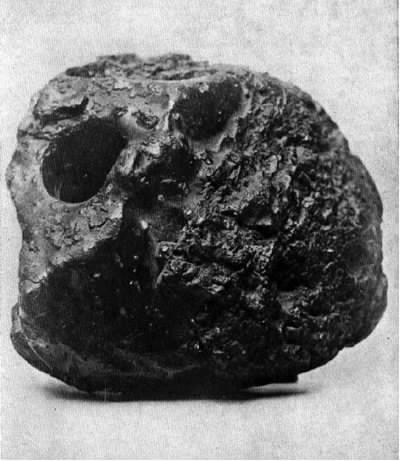
A coal torpedo. This example was prepared as a model, with a partial coal dust coating and the plug left out. It was found in Jefferson Davis' office by Union General Edward Ripley when Union forces captured Richmond in April 1865. (Gen. Ripley does not appear to be any relation to the Ordance Dept. Ripley.)
From the Wikipedia entry on "coal torpedo." (I don't trust Wikipedia as a source, but this could certainly serve as a lead to a source.
First published in 1907, Edward Ripley, The capture and occupation of Richmond.
Photograph of the sidewheeler Greyhound. The original photograph is at the Mariners Museum in Newport News, Virginia. As the Greyhound was destroyed in November, 1864, this photograph is at least 140 years old. This is Butler's Greyhound.
(picked up from Wikipedia coal torpedo entry.)
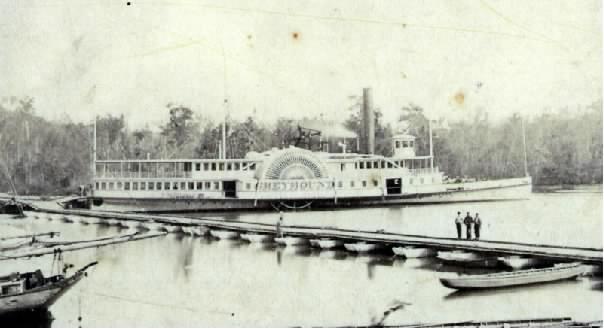
There are some truly excellent computerized reconstructions of the Hunley at http://home.att.net/~JVNautilus/Hunley/reconstruction.html
"The Hunley Reconstruction."
see this website for good sources on images of Alligator, Hunley, etc.
http://americancivilwar.com/tcwn/civil_war/naval_submarine.html
many good illos of the hunley at hunley.org and at http://www.history.navy.mil/photos/sh-us-cs/csa-sh/csash-hl/hunley.htm
This image is from http://www.hunley.org/main_index.asp?CONTENT=CIVILWAR and shows the Hunley being transported aboard a train from Mobile to Charleston.. Note the caption, which makes it pretty clear this is an "artist's conception" -- not an image of the real event.. The same page has a version of the Anaconda cartoon.
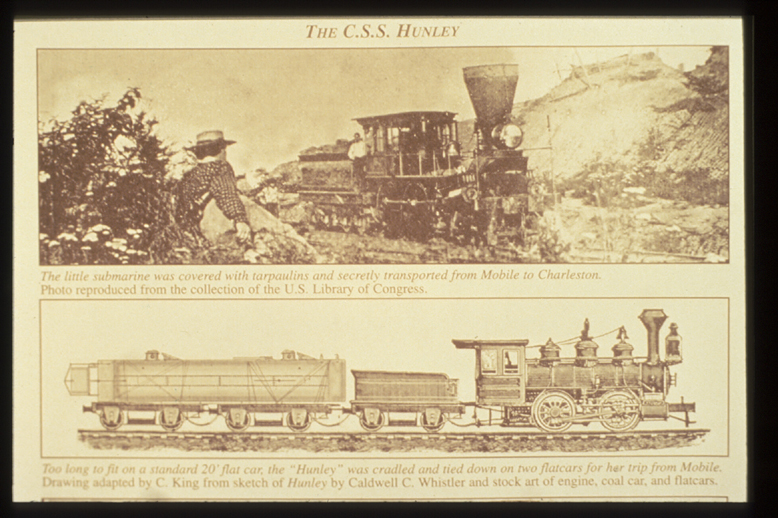
This cartoon, Running the Machine, is a hoot. See http://loc.harpweek.com/lcpoliticalcartoons/DisplayCartoonMedium.asp?MaxID=&UniqueID=29&Year=1864&YearMark=
for a pretty washed-out version of it. This greyer but better version is at http://en.wikipedia.org/wiki/Image:RunningtheMachine-LincAdmin.jpg
This would appear to be image 45978 from the Naval History Collection, though I did not find it listed online that way. Probably it can be located with a phone call.
See http://www.history.navy.mil/branches/org11-2.htm for lots of ship images.
http://www.history.navy.mil/photos/sh-usn/usnsh-k/kearsarg.htm
for shots of the Kearsarge, but some views of it aren't shown, including this one:, NH 52029. Again, a phone call ought to get more.
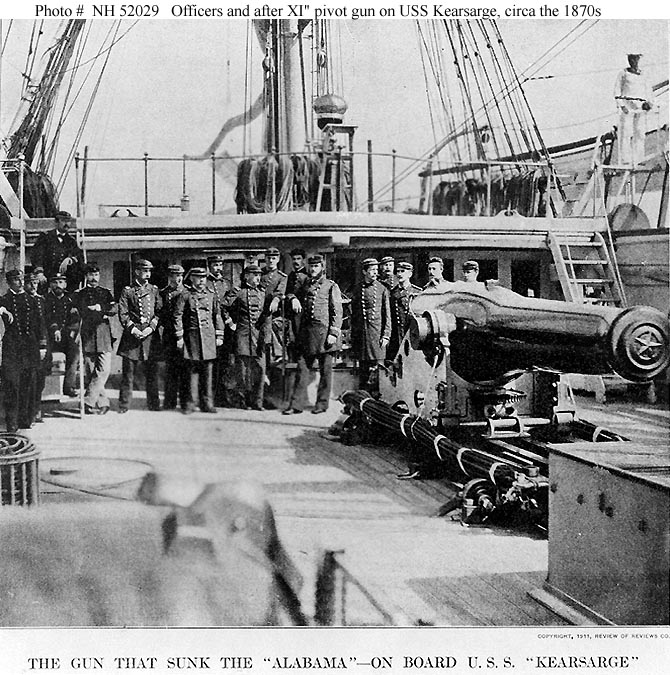
The images below are pages from the Official Records, showing diagrams of how mines were laid by the CSS Teaser in the James River. Note page numbers, and volume numbers at bottom of second page. The top lines of page 544 are a report from the Union officer who captured the Teaser at about the same time. The "shells with peculiar fuzes" were very likely the torpedoes, or mines, some of which Matthew Fontaine Maury (my sons' Great-Great-Great-etc Uncle, for whom my elder son is named) had just laid.
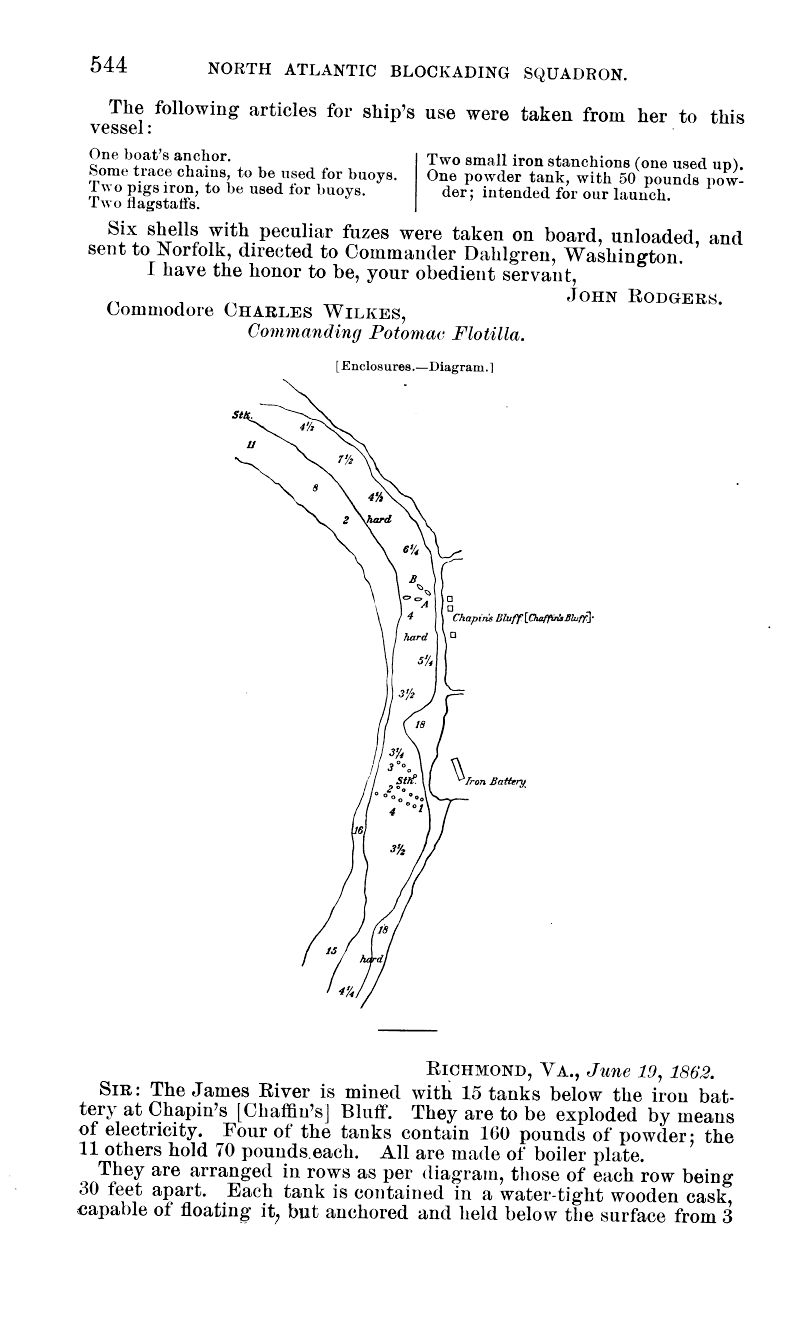
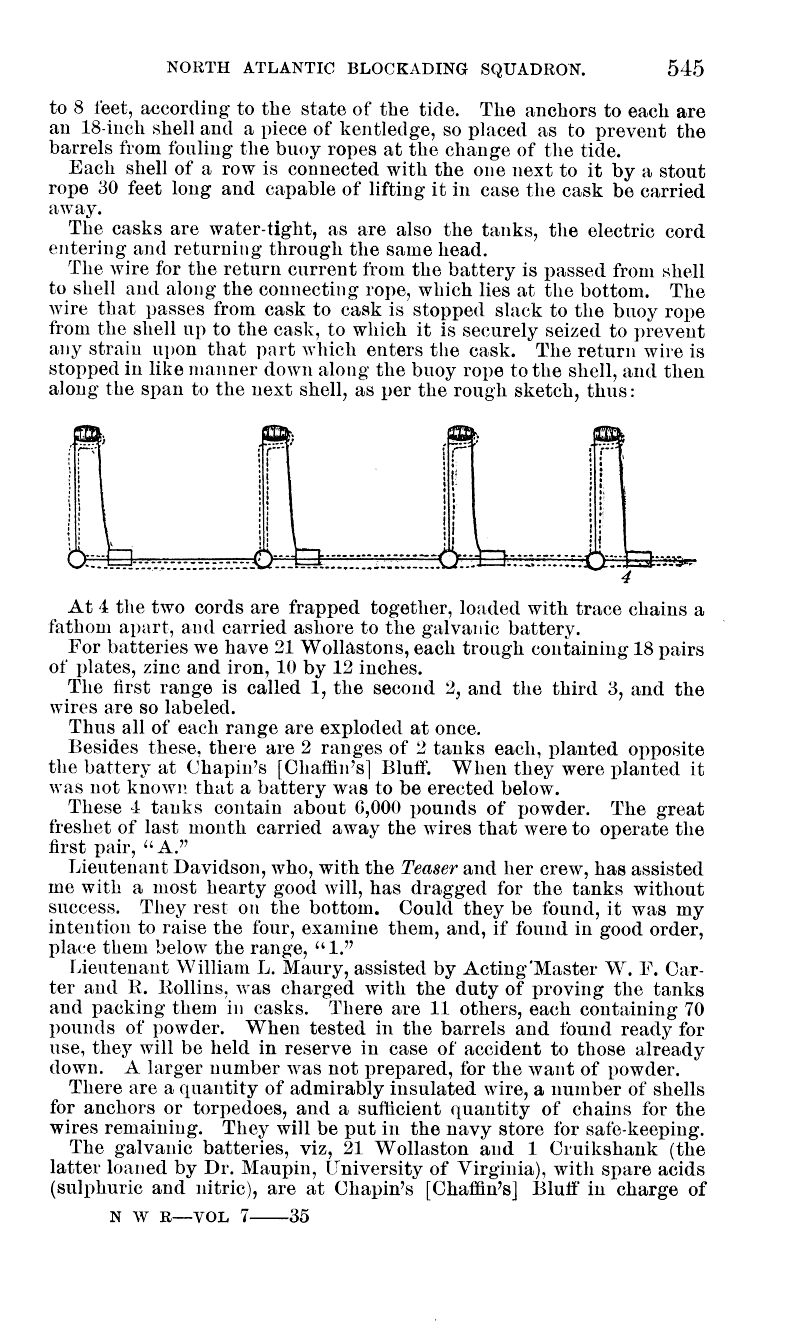
I scanned this image (below) of Lincoln writing the Emancipation Proclamation from LINCOLN by David Herbert Donald. Note caption info on sources, and image credit line of The Lincoln Museum. The same spread in Donald's book showed an anti-proclamation cartoon of a devilish Lincoln, but that's not what our book is about. The point of this illustration is that the writing was idealized, whereas Lincoln really did it between telegrams in the War Dept. Telegram office.
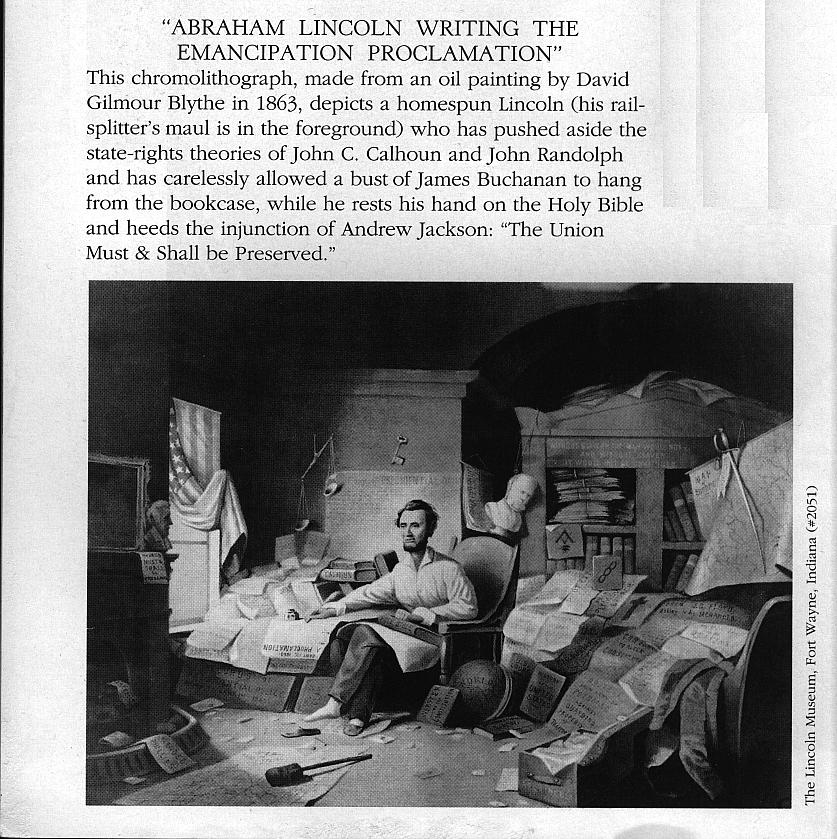
I found this color version of the same image at http://americanrevwar.homestead.com/files/civwar/proc.html.
I think it would be worth tracking down the original by David Gilmour Blythe. There's lots of fun allegorical items -- the flag raised to let in sunlight, the key on the wall, the uneven scales of justice, the masonic symbol, etc.
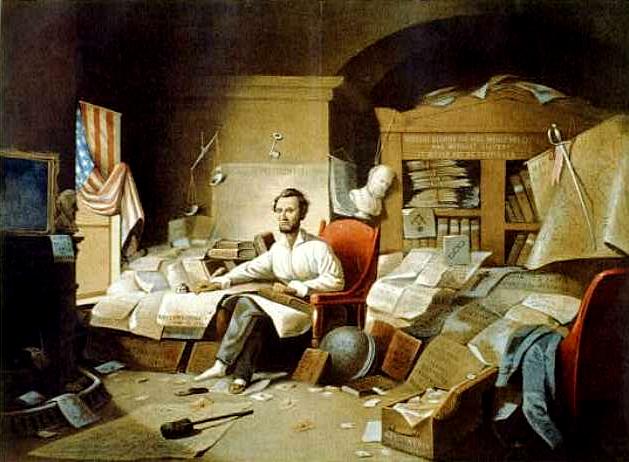
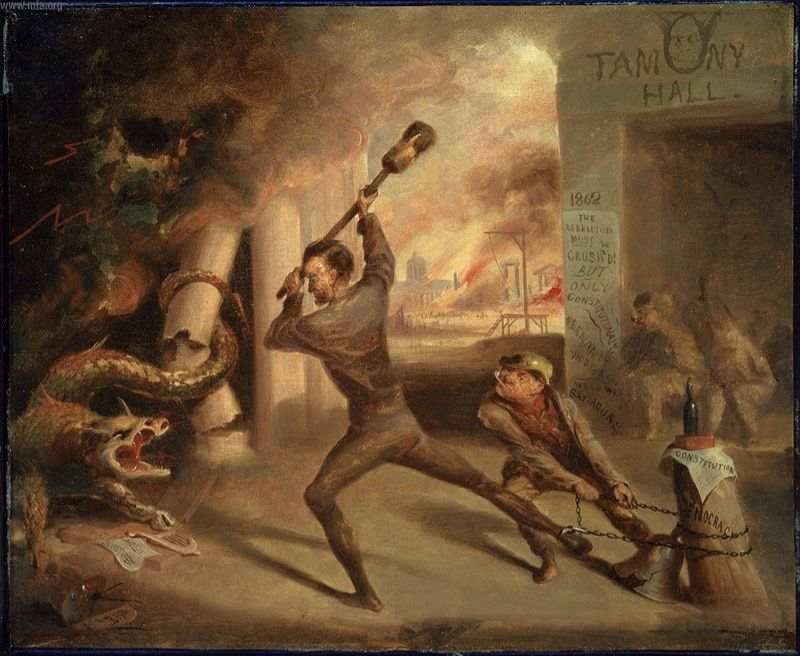
This is another Blythe painting, from the Museum of Fine Art, Boston. Lincoln is using his railsplitter's maul to beat back the dragon of rebellion, but is chained to a stumped label democracy, with the Constitution sitting on top of it, with a book (perhaps the bible? and a bottle (Rum and Romanism?) holding the Constitution in place. The whole affair is braced up against a cracked Liberty Bell. A couple of disreputable types lounge in the entrance of Tamony (obvious pun with money) Hall. Grafiitti scrawled on the Hall warns the rebellion can only be crushed by constitutional means. It is signed by Fernando Wood, (the pro-seccessiononist mayor of New York, who even toyed with seceding the city itself out of the Union) & co, "need we Saymour" a pun on the name of Horatio Seymour, the Governor of New York, who opposed many of Lincoln's measures, such as the draft, limits on personal liberty, and the Emancipation Proclamation. This would be an interesting illustration of the "fire in the rear" aspect of total war.
Click here to link to MFA's page on this image
Lincoln Crushing the Dragon of Rebellion
1862
Oil on canvas
45.72 x 55.88 cm (18 x 22 in.)
Museum of Fine Arts, Boston
Bequest of Martha C. Karolik for the M. and M. Karolik Collection of American Paintings, 1815-1865
48.413
© 2007 Museum of Fine Arts, Boston
See below for MFA Boston's description of this painting, LIBBY PRISON
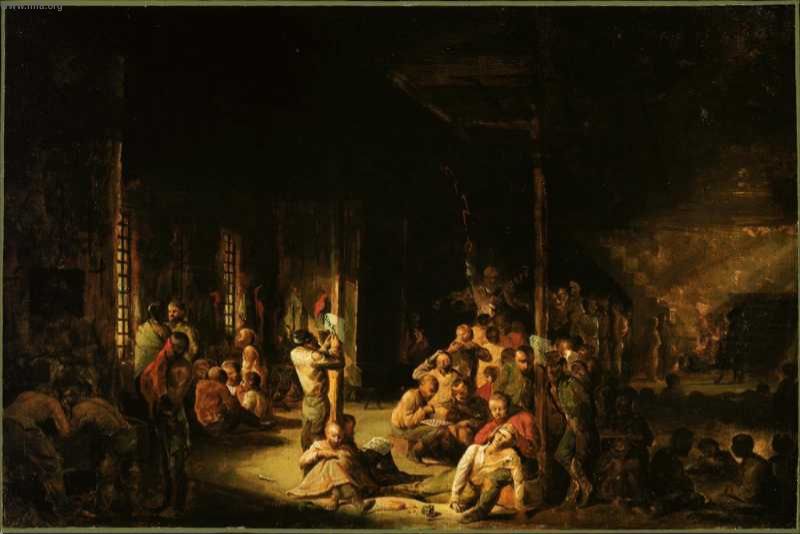
Libby Prison, in Richmond, Virginia, was one of the most notorious Confederate prisons in operation during the Civil War. The building was originally a tobacco warehouse, constructed by local merchant Fulton Libby in 1845; by 1862, it was a filthy, vermin-infested, dank prison, housing as many as twelve hundred Union soldiers in six rooms each no more than forty by one hundred feet. Many prisoners died there; those who survived suffered from poor health for the rest of their lives.
David Gilmour Blythe, a self-trained artist with a satirist's eye and a keen dramatic sense, never saw Libby Prison. He spent the war years in Pittsburgh and relied on newspaper accounts and prints of the prison for information about the setting and the prisoners' wretched lives. Some of his details are true to life-men play cards and checkers to pass the time, others wash themselves at a water trough; a soldier at center comforts a feverish friend. Other elements are broadly satirical-a man at center writes "Time" on a post, while another reads Rip Van Winkle (as though relief could be found in a story of twenty years' slumber); the chaplain at center right offers sham solace to the despondent men. Although many of his figures are crudely drawn, Blythe's use of lighting is deftly theatrical, and his rich red-and-brown color scheme intensifies the emotion of the scene. Beneath the propagandistic accumulation of horrifying detail are echoes of several famous European paintings dealing with related themes, which Blythe likely would have known through prints. The similarities with William Hogarth's Bedlam (the final scene in his epic series of paintings "The Rake's Progress," which were widely distributed in prints) and Baron Gros' General Bonaparte Visiting the Plague-Stricken at Jaffa (Musée du Louvre; a version is in the MFA) suggest that the inhumanity of Libby Prison was not limited to the Civil War or America, but was part of the larger, age-old story of man's inhumanity to man.
This cartoon, also from the Donald book, and the same museum as the Emancipation Proclamation image above, mocks Lincoln for sneaking into Washington.
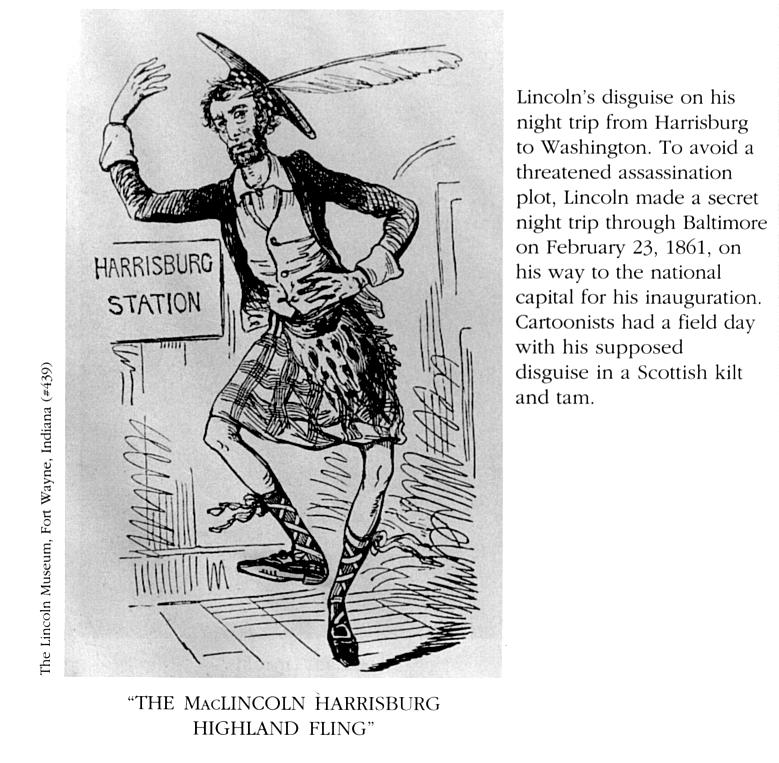
This image of the first purpose-built aircraft carrier, the George Washington Parke Custis, is from THE EAGLE ALOFT by Thomas Crouch, Smithsonian Press, 1983, which credits it as a National Air and Space Museum photo. A murkier version of the same images is at http://www.history.navy.mil/danfs/g4/george_washington_parke_custis.htm.
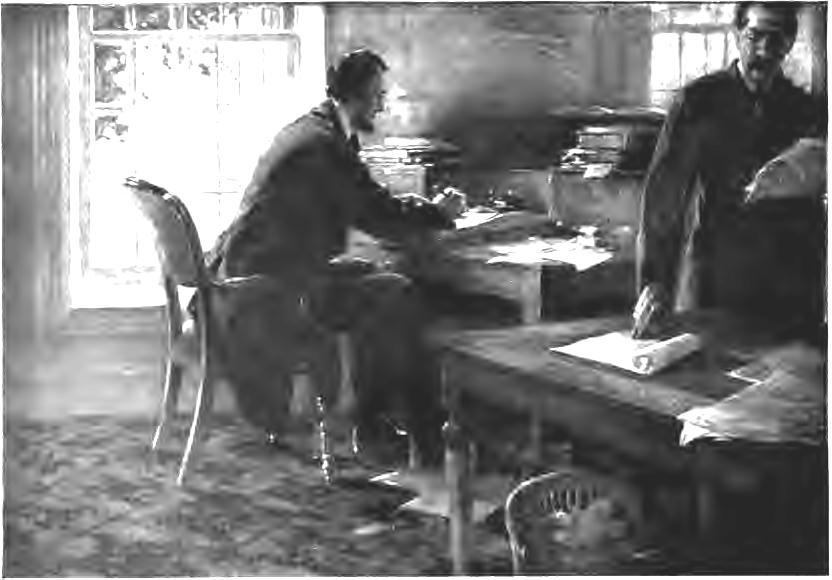
This drawing of Lincoln working on the first draft of the Emancipation Proclamation in the Telegraph Office is by C.M. Relyea, and appears as the frontispiece of the 1907 book LINCOLN IN THE TELEGRAPH OFFICE by David Homer Bates, who was the manager of the War Dept. Telegraph Office. This version of the image was picked up from a pretty murkily scanned book downloaded via Google Books. Almost certainly, a much better image could be obtained by scanning an original copy of the book.
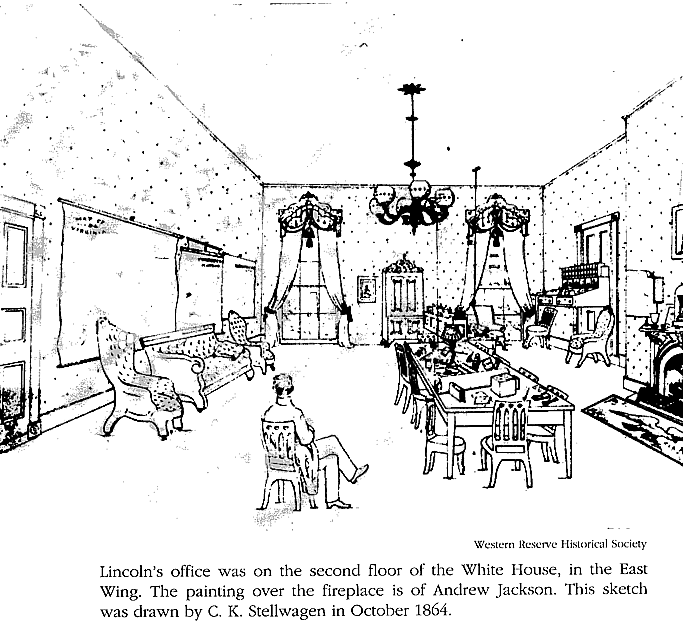
This sketch appears in the photo section of David Herbert Donald's Lincoln. Note the credt to Western Reserve Historical Society. The image as reproduced in the book shows the fireplace and the portrait over it more fully, but it was no possible to scan the close to edge of the page. It should be noted that this is a fairly low-quality scan of the image, due to difficulty in scanning printed line art. It wasn't easy to deal with the Moire patterns.